What Is the Difference Between Djembe and Bongo?
The difference between djembe and bongo isn’t just about how they look. It’s about where they come from, how they’re made, and the kinds of music they support. Even though you play both with your hands, they are basically different tools made for separate jobs. Understanding this helps you choose the right instrument for your own style and musical goals.
If you’re trying to choose the right drum for your music, or just want to understand their roles better, this article will help.
You’ll learn:
- How a djembe compares to a bongo in design and tone
- Where each drum comes from and how that shapes their sound
- Which drum fits better depending on what you play
- And practical tips if you want to buy or learn either one
Let’s break it down drum by drum.
Where Do These Drums Come From? A Tale of Two Continents
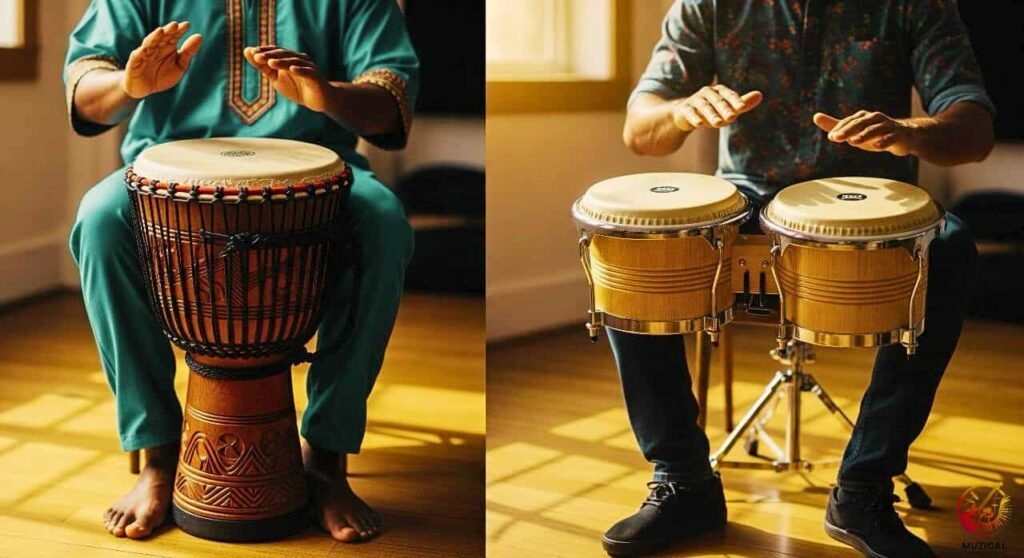
To truly understand the difference between djembe and bongo, we need to look at their unique stories. Their origins are separated by an ocean and hundreds of years, which is the first big clue to how different they are.
Djembe
The djembe is a very old drum from West Africa, first made by the Malinke people around the 12th century. It was more than just an instrument; it was a tool for communication and an important part of ceremonies.
Carved from a single log with a goatskin top, the djembe was used for storytelling, dances, and big life events like weddings and harvests. Its name, djembe (jem-bay), is said to come from a phrase meaning “everyone gather together in peace.” In music, the djembe often acts as a lead instrument with a powerful voice that guides the group.
Bongo
On the other hand, bongos are much newer. They were invented in Cuba during the late 1800s. They came from the island’s mix of African and Spanish cultures and were created to play a new, popular music called son cubano.
Unlike the single djembe, bongos are a pair of small drums, the smaller macho and the larger hembra. Their job isn’t to be a loud solo drum. Instead, they provide a high-pitched, driving rhythm that makes people want to dance. They are an accompaniment instrument, designed to lock in with the rest of the band.
So, one drum is ancient and from Africa with a spiritual role, while the other is a more recent pair from Cuba made for social music.
What Makes Them Look So Different? Anatomy of a Hand Drum
You can tell just by looking that a djembe and a set of bongos are not the same. The way they are built is a key part of the difference between djembe and bongo, as it creates their unique sounds.
Djembe
A djembe is a large drum shaped like a goblet or a cup. This shape acts like a natural megaphone, making the sound big and loud. The wide top bowl helps create deep bass sounds, while the narrow bottom helps send the sound out.
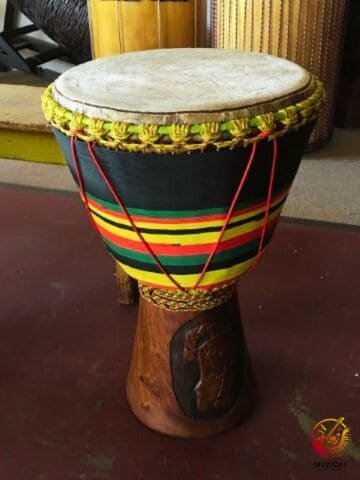
The shell is carved from one single piece of wood, and the head is usually made of thin goatskin. This thin skin is what helps make the djembe’s special high-pitched “slap” sound. To tune the drum, players tighten a series of special ropes.
Bongo
Bongos, however, are made to create a very different sound. They are a pair of small, open-bottomed drums joined together by a block of wood. Instead of ropes, modern bongos use metal screws and holders called lugs to tune the head, much like a snare drum.
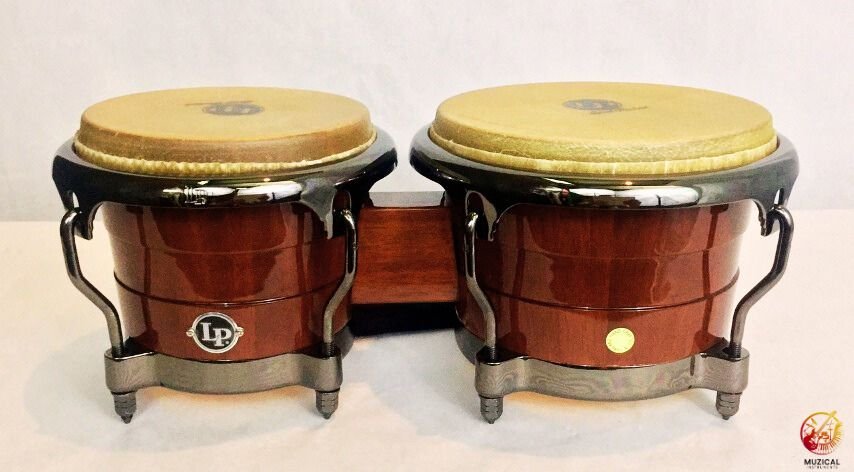
This system allows the head to be pulled very tight, which is needed to get the crisp, popping sounds bongos are famous for. Their drum heads are also made from thicker cowhide. This thicker skin creates a sharp tap instead of the deep, booming sound of a djembe.
| Feature | Djembe | Bongo |
|---|---|---|
| Origin | West Africa (c. 12th Century) | Cuba (c. 19th Century) |
| Number of Drums | One (single drum) | Two (a connected pair) |
| Shape | Large goblet shape with a narrow foot | Small, tapered, open-bottomed cylinders |
| Tuning System | Rope and ring system (Mali Weave) | Metal tuning lugs and rim |
| Traditional Head | Goatskin (thin) | Cowhide or Mule hide (thick) |
| Typical Role | Lead voice, solo instrument | Rhythmic accompaniment |
| Size & Weight | Large and relatively heavy | Small, compact, and lightweight |
How Do You Actually Play Them? Exploring Different Techniques
How you play these drums shows another big difference between djembe and bongo. You can’t play them the same way and expect to get the right sound. The hand positions and main rhythms are completely different.

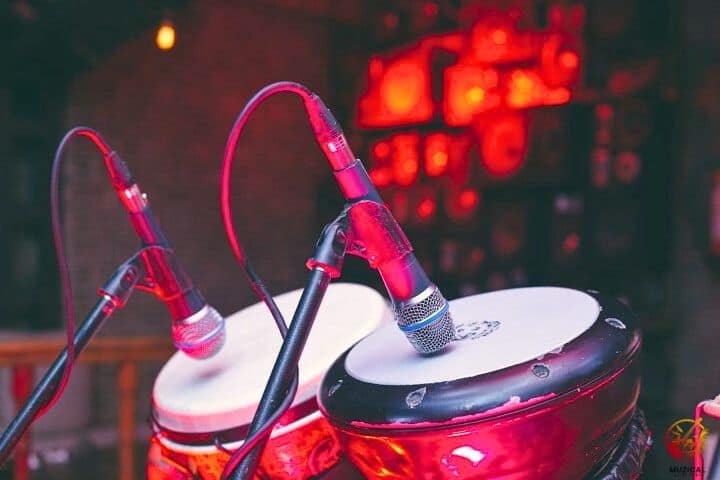
Djembe
To play a djembe, you usually sit down and hold it between your knees. You have to tilt it forward so the sound can get out of the bottom. Djembe playing uses your whole hand to make three main sounds:
- Bass: A deep, booming sound made by hitting the center with your flat palm.
- Tone: A full, round sound made by hitting near the edge with your fingers together.
- Slap: A sharp, high-pitched sound made by hitting the very rim with your fingertips.
Bongo
Bongo playing is totally different and focuses on using your fingers and thumbs with speed. You sit and hold the pair of drums between your knees. Instead of big, powerful hits, you play quick, detailed patterns.
The main bongo rhythm is called the martillo (which is Spanish for “hammer”). This is a constant, fast pattern that uses a mix of taps and hits on both drums. It creates a “conversational” feel and drives the music forward with energy, rather than with loud, booming sounds.
Which Drum Fits My Musical Style? Sound and Application
Choosing your drum really depends on the sound you want and the music you like. The sound they create is a huge part of the difference between djembe and bongo, and it changes the jobs they do in a band.
Djembe
The djembe has a wide range of sounds. It can make a deep bass sound you can feel, a warm middle tone, and a sharp, high slap that can be heard over other instruments. Because it’s so powerful and loud, the djembe can easily be the main drum in a group.
It’s the star in West African music and very popular in drum circles. In modern music, it’s used in acoustic rock and world music to add an earthy feel. If you need one drum to cover bass, melody, and rhythm, the djembe is a great choice.
Bongo
The sound of the bongos is the complete opposite. It’s all about high, clear, and sharp tones. There is almost no bass sound at all. The focus is on the quick, back-and-forth “chatter” between the smaller and larger drums. Bongos are not meant to be a loud solo drum. Instead, their job is to add a layer of excitement and texture to the rhythm. This makes them perfect for many types of Latin music, like salsa and mambo, where their constant pattern adds energy. If you want to play fast, detailed rhythms in a bigger band, bongos are the right tool.
| Aspect | Djembe | Bongo |
|---|---|---|
| Primary Sound Profile | Deep resonant bass, full mid-tones, and sharp, high-pitched slaps. | Crisp, articulate, high-pitched tones. No significant bass. |
| Volume Potential | Very loud; can easily lead an ensemble. | Moderately loud; designed to blend into a rhythm section. |
| Common Genres | West African, World Music, Fusion, Drum Circles, Acoustic Pop/Rock. | Salsa, Son Cubano, Mambo, Latin Jazz, Cha-Cha-Chá. |
| Typical Ensemble Role | Often a lead or solo instrument, providing the main rhythmic voice. | Rhythmic accompaniment, providing a constant, driving pattern. |
What is the Difference Between Djembe and Bongo for a Beginner?
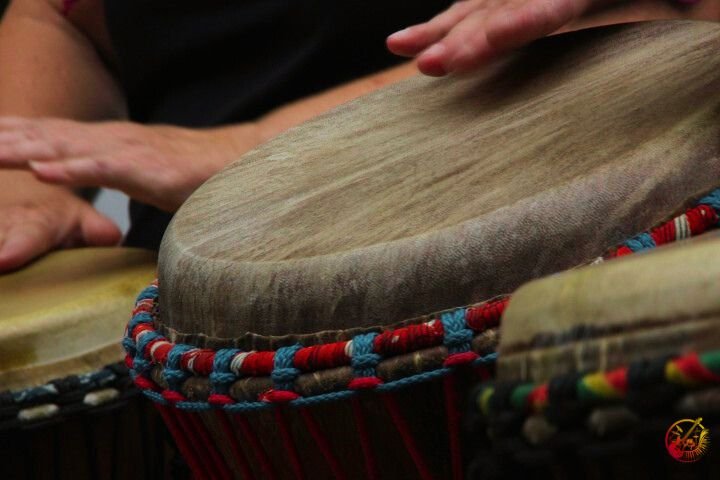

For a new player, a key difference between djembe and bongo is how easy they are to start playing. The right choice for you will depend on your goals.
Djembe
With a djembe, it’s fairly easy to get a good-sounding bass and tone right away. You can be playing simple, fun rhythms in just a few minutes.
However, learning to make the sharp “slap” sound correctly is difficult and takes a lot of practice. The djembe is a great starting point if you want to play solo or be the main rhythm in a casual drum circle.
Bongo
Bongos offer a different challenge. The first step is learning the main martillo pattern, which requires good timing and finger control from the start. You won’t get the deep boom of a djembe, but learning the martillo helps you build a strong foundation in rhythm that is useful for many other hand drums.
You should also think about size and cost. Bongos are smaller, lighter, and a good starter set often costs less. A full-size djembe is bigger, heavier, and a quality hand-carved one can be more expensive.
The best way to decide is to try both if you can. Visit a music store, sit down with them, and tap the drum heads. The one that feels more natural and has a sound that excites you is the right drum for you.
Which Drum Should You Choose Based on Your Goals?
Here’s a quick guide based on what kind of player you are.
| If You Want To… | Choose… |
|---|---|
| Lead in a drum circle | Djembe |
| Play in a Latin or salsa band | Bongo |
| Practice meditative or therapeutic drumming | Djembe |
| Jam casually with friends | Bongo |
| Learn deep traditional rhythms | Djembe |
| Add light percussion to acoustic sets | Bongo |
| Explore expressive solo performance | Djembe |
The Final Beat
To summarize, the difference between djembe and bongo is a story of contrast at every level. It’s West Africa vs. Cuba, ancient vs. modern, a single goblet vs. a connected pair, booming bass vs. high-pitched chatter, and a lead solo voice vs. a driving rhythmic accompaniment. One is not better than the other; they are simply distinct instruments built for different musical conversations.
Your choice should be guided by the music you love and the role you want to play within it. Do you want to be the powerful, central voice of the rhythm, or do you want to be the agile, energetic force that makes people want to dance?
I encourage you to listen with intent. Put on some music by a djembe master like Mamady Keïta. Then, listen to the classic bongos on a record from the Buena Vista Social Club. Close your eyes and focus only on the drums. Which voice speaks to you? The answer to that question will tell you everything you need to know.
To truly understand what makes the djembe unique, you should explore the spiritual power of the djembe that goes beyond rhythm.
FAQ: The Difference Between Djembe and Bongo
Q1. Are djembes louder than bongos?
Yes, djembes are typically louder than bongos. A djembe’s wide head and deep shell give it a strong projection and powerful bass. It can fill a large space easily, even outdoors. Bongos are smaller and have a higher pitch, so their volume doesn’t carry as far. If you need to lead a group or play outside, the djembe wins on volume.
Q2. Which is better for beginners: djembe or bongo?
Bongos are easier for most beginners. They’re smaller, lighter, and take less strength to play. You can learn basic rhythms fast. Djembes need more hand control and practice to produce clean tones. But if you enjoy big sounds and full-arm movement, the djembe might still be the better choice.
Q3. What type of music uses djembes?
Djembes are used in traditional West African music, drum circles, world music, and even in some fusion and healing music. They often take a lead rhythm role, especially in cultural and spiritual gatherings.
Q4. What type of music are bongos used in?
Bongos are popular in Latin styles like salsa, son Cubano, mambo, and Latin jazz. They’re also used in reggae, pop, acoustic, and indie music for light percussion accents. Bongos work well in fast-paced, rhythmic genres.
Q5. Can you use both djembe and bongos in the same band?
Yes, but it depends on the style of music. In world fusion or experimental setups, you can blend both. The djembe can hold down the low-end rhythm, while the bongos add brightness and accents. Just make sure they don’t clash, each has its space.
Q6. Which is more portable: bongo or djembe?
Bongos are more portable. They’re lighter, smaller, and easier to carry around. Djembes are larger and can be bulky, especially for kids or travelers. If you want to throw something in a backpack, go with bongos.
Q7. Are djembes more expensive than bongos?
In general, yes. Djembes made from carved hardwood and real goat skin tend to cost more than entry-level bongos. However, prices vary. You can find high-end professional bongos that cost more than a basic djembe. Materials, craftsmanship, and brand all affect the price.
